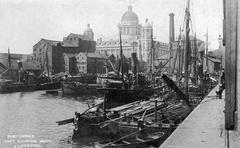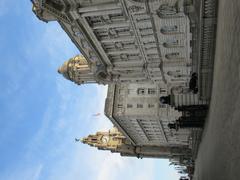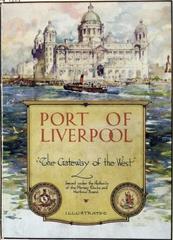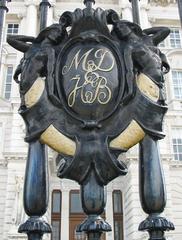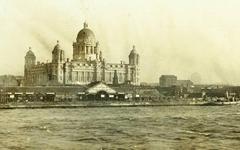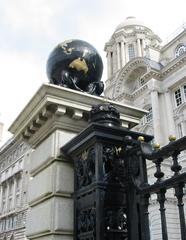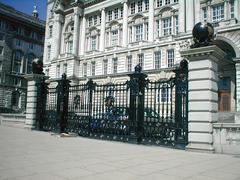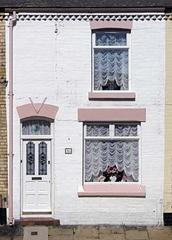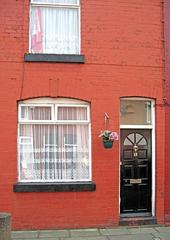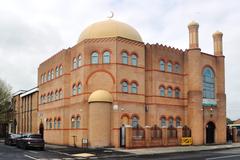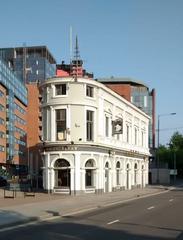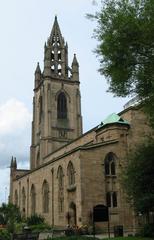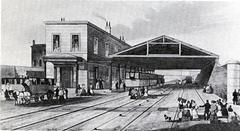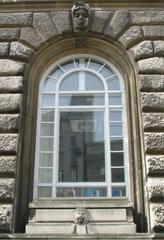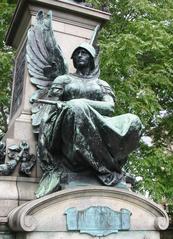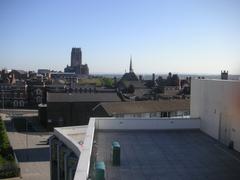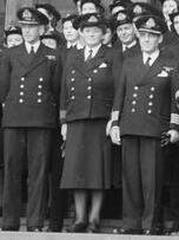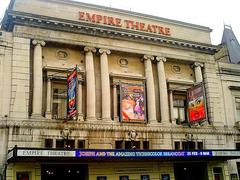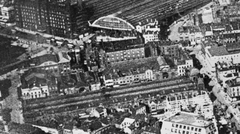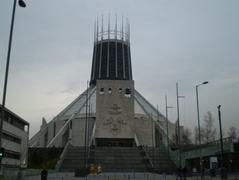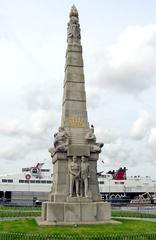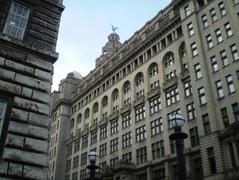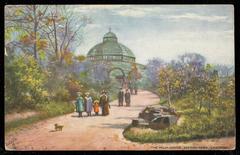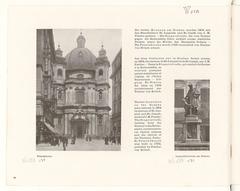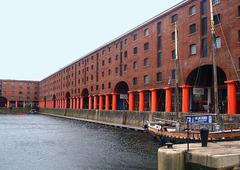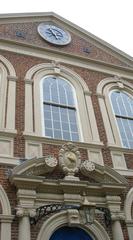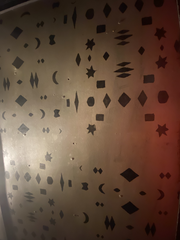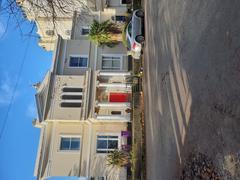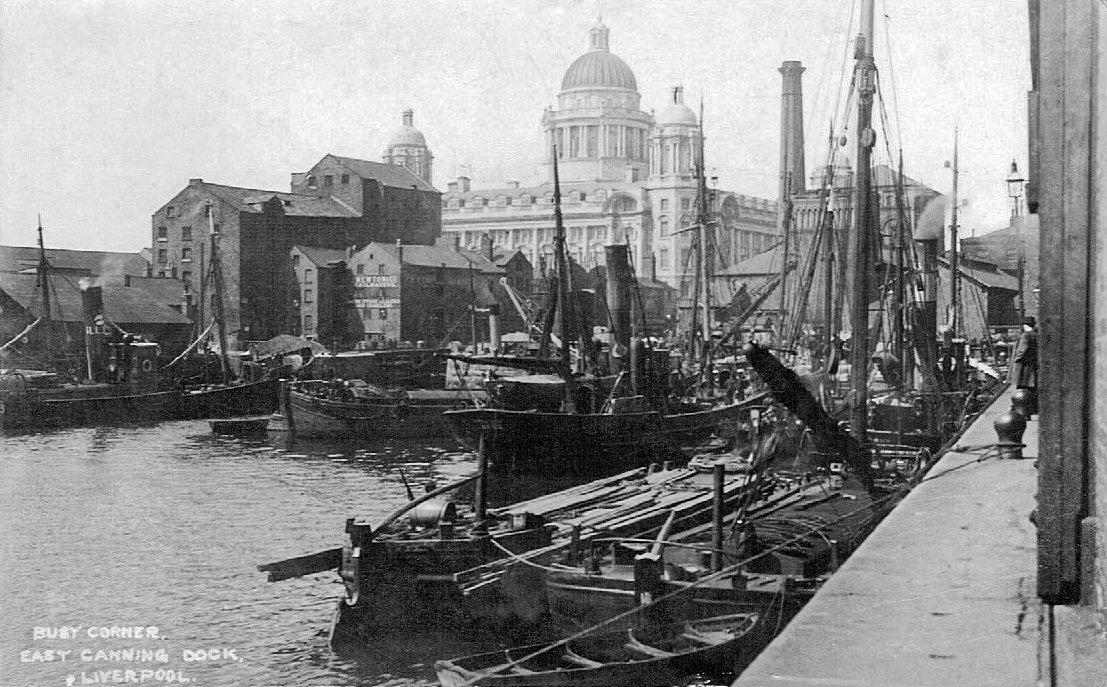
Liverpool Port of Liverpool Building: Visiting Hours, Tickets, and Historical Significance
Date: 15/06/2025
Introduction
Nestled on Liverpool’s iconic Pier Head waterfront, the Port of Liverpool Building stands as a monumental emblem of the city’s maritime heritage and architectural grandeur. Completed in 1907, this Edwardian Baroque masterpiece originally served as the headquarters of the Mersey Docks and Harbour Board, symbolizing Liverpool’s prominence as a global shipping center during the late 19th and early 20th centuries. Alongside the Royal Liver Building and the Cunard Building, it forms part of the celebrated “Three Graces,” which define Liverpool’s historic waterfront skyline (Only in Liverpool, World City Trail).
Today, while the building functions as a modern office space, its ground floor remains open to the public during business hours, offering visitors a chance to admire its grand architecture and learn about Liverpool’s maritime legacy. This guide details visiting hours, ticket information, accessibility, nearby attractions, and the building’s enduring historical and cultural significance.
Contents
- Historical Background
- Architectural Significance
- Visiting Information: Hours, Tickets, and Accessibility
- Restoration and Preservation
- Heritage Status
- Nearby Attractions and Cultural Highlights
- Practical Travel Tips
- Frequently Asked Questions (FAQ)
- Conclusion and Call to Action
- Sources
Historical Background
Origins and Maritime Context
The Port of Liverpool Building was constructed as the headquarters of the Mersey Docks and Harbour Board, reflecting Liverpool’s explosive growth as a global port during the Industrial Revolution. By the late 1800s, Liverpool had become one of the world’s busiest ports, central to transatlantic trade and migration. The MDHB managed one of the most extensive dock systems globally, with over 40 docks at its peak, playing a key role in the movement of goods and people across the world (Only in Liverpool, BBC News).
Construction and Timeline
Built between 1904 and 1907 on the site of the former George’s Dock, the Port of Liverpool Building was the first of the “Three Graces” to be completed. Designed by Sir Arnold Thornely and F.B. Hobbs with assistance from Briggs and Wolstenholme, its construction marked a high point in Liverpool’s maritime era (World City Trail).
Role in Liverpool’s Maritime Heritage
The building served as the administrative heart of the city’s dock system, embodying Liverpool’s global maritime reach. Despite changes in shipping technology and trade patterns leading to the port’s decline in the mid-20th century, the building remains a powerful symbol of Liverpool’s seafaring legacy.
Architectural Significance
Design and Style
The Port of Liverpool Building is a prime example of Edwardian Baroque architecture, characterized by its grand Portland stone façade, central copper-clad dome, and ornate maritime motifs such as anchors, shells, and tridents. The symmetrical layout, imposing columns, and Beaux-Arts influences exemplify early 20th-century British civic architecture (World City Trail).
Structural Innovations
Innovative steel frame construction allowed for greater height and spacious interiors. The use of high-quality materials, including marble, oak, and decorative plasterwork, is particularly evident in the central hall beneath the dome.
Relationship to the Three Graces
Together with the Royal Liver Building and the Cunard Building, the Port of Liverpool Building anchors one of the UK’s most recognizable skylines. Although Liverpool lost its UNESCO World Heritage status in 2021 due to urban developments, the Three Graces continue to symbolize the city’s historic and cultural prominence (World City Trail).
Visiting Information: Hours, Tickets, and Accessibility
Visiting Hours
- Ground Floor Access: Monday to Friday, 9:00 AM to 5:00 PM. Closed on weekends and public holidays.
- Exterior Viewing: The façade and surrounding public spaces are accessible at all times.
- Guided Tours: Offered on select days (often during Heritage Open Days or special events). Check local heritage organizations or the official Port of Liverpool Building website for schedules.
Tickets and Entry
- Ground Floor Admission: Free.
- Guided Tours/Special Events: Usually ticketed; prices typically range between £5–£10. Advance booking is recommended for special access.
Accessibility
- Wheelchair Access: Ramps and lifts are available.
- Facilities: Modern WC and shower facilities, high-specification cycle storage, and limited on-site parking.
- Assistance: Reception staff can assist with specific needs; it is advisable to contact ahead for any special requirements.
Restoration and Preservation
Early Preservation and Ownership Transition
After the MDHB vacated the building in 1994, it faced neglect until property developer Downing acquired it in 2001, initiating restoration efforts (Only in Liverpool, Downing Case Study).
Major Restoration (2006–2009)
A £10 million restoration between 2006 and 2009 revitalized both exterior and interior features:
- Exterior: Cleaning and repairing Portland stone, re-glazing the dome, and enhancing exterior lighting.
- Interior: Restoration of marble walls, terrazzo floors, stained glass windows, and decorative plasterwork. Upgrades were made to lifts and lighting while preserving historic ambiance.
- Systems: Modernized mechanical and electrical systems, fire safety, and emergency lighting.
Ongoing Use
Now a multi-tenant office building, it houses organizations such as Rathbones, DHL, and Hapag Lloyd, with daily maintenance and preservation practices integrated into its operation (Only in Liverpool).
Heritage Status
Grade II* Listing
The building’s Grade II* listing by Historic England protects it from unauthorized alterations, ensuring its historical character is maintained (Only in Liverpool).
UNESCO Recognition
The Port of Liverpool Building was part of the Liverpool Maritime Mercantile City UNESCO World Heritage Site from 2004 until its delisting in 2021, primarily due to urban development concerns (UNESCO; Reason.com). Despite this, the building remains a cherished symbol of Liverpool’s heritage.
Local Significance
As one of the “Three Graces,” it is a focal point for heritage tourism and civic pride (Culture Liverpool).
Nearby Attractions and Cultural Highlights
The Three Graces and Pier Head
The Port of Liverpool Building is joined by the Royal Liver Building and the Cunard Building, forming the centerpiece of the Pier Head and Liverpool’s historic waterfront.
Royal Albert Dock
A 10-minute walk from the Pier Head, Royal Albert Dock offers museums, galleries, and restaurants in a revitalized Victorian setting (Tourist Secrets). Highlights include:
- Merseyside Maritime Museum: Explores Liverpool’s maritime history, including the Titanic and transatlantic trade (Adventour Begins).
- Tate Liverpool: Showcases modern and contemporary art.
- The Beatles Story Museum: Dedicated to Liverpool’s most famous band.
Museums and Cultural Venues
- Walker Art Gallery: Renowned for European and British art.
- International Slavery Museum: Focuses on the transatlantic slave trade.
- Museum of Liverpool: Chronicles the city’s history and culture.
Music, Nightlife, and Pop Culture
- Cavern Club: Legendary music venue linked to The Beatles (Adventour Begins).
- Baltic Triangle: A hub of creativity, nightlife, and street art.
- Filming Locations: The building has featured in films such as “Yesterday” and TV series like “Peaky Blinders” (The Guide Liverpool).
Architectural and Historic Landmarks
- St. George’s Hall: A neoclassical civic building.
- Liverpool Cathedral: One of the world’s largest cathedrals.
- Ropewalks District: Known for its historic warehouses and vibrant culture.
Shopping and Dining
- Liverpool ONE: A major shopping and leisure complex.
- Royal Albert Dock and Pier Head: Offer a range of dining options with waterfront views (Adventour Begins).
Practical Travel Tips
- Transport: The building is easily accessible by train (James Street station), bus, or on foot from Liverpool city center.
- Accessibility: The area is pedestrian-friendly and mostly flat.
- Photography: The waterfront promenade is ideal for photos, especially at sunrise or sunset.
- Events: Check local listings for festivals, exhibitions, and seasonal events on the waterfront (Tourist Secrets).
Frequently Asked Questions (FAQ)
Q: What are the Port of Liverpool Building visiting hours?
A: The ground floor is open Monday to Friday, 9:00 AM to 5:00 PM. The exterior and surrounding spaces are accessible at all times.
Q: Is there an entry fee?
A: Ground floor access is free. Guided tours or special events may require tickets.
Q: Are guided tours available?
A: Yes, but only on select days or during special events. Check official sources for schedules.
Q: Is the building wheelchair accessible?
A: Yes, with ramps and lifts available.
Q: Can I take photographs?
A: Exterior and ground floor photography is permitted. Interior photography may be restricted during special events.
Conclusion and Call to Action
The Port of Liverpool Building remains an enduring icon of Liverpool’s maritime history and architectural excellence. As one of the city’s “Three Graces,” it offers visitors an opportunity to delve into Liverpool’s illustrious past while enjoying the vibrant atmosphere of the modern waterfront. Whether you’re interested in history, architecture, or culture, a visit to the Port of Liverpool Building and the surrounding attractions is a must.
For the latest information on visiting hours, ticketing, and events, consult official sources or local heritage organizations. To enrich your experience, download the Audiala app for curated audio guides, and explore our resources on Liverpool’s top historical sites and cultural festivals.
Sources and Further Information
- Only in Liverpool - Port of Liverpool Building
- Port of Liverpool Building: Visiting Hours, Tickets, and Heritage Insights - Downing Case Study
- UNESCO World Heritage Site
- Reason.com - Liverpool World Heritage Delisting
- The Guide Liverpool - 8 Things You Might Not Know
- Adventour Begins - Liverpool Cruise Port Guide
- Tourist Secrets - Liverpool: It’s So Much Nicer Than You Think
- Culture Liverpool - Heritage & History
- World City Trail - The Three Graces in Liverpool
